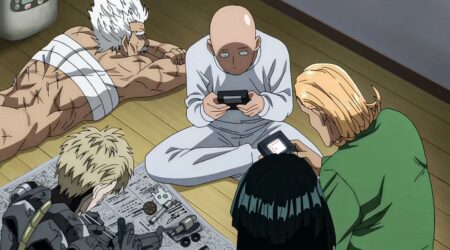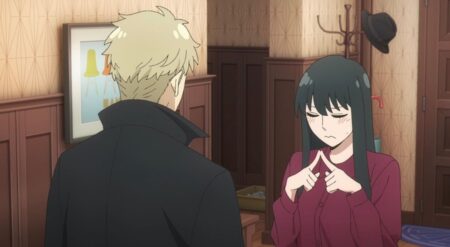Too Many Losing Heroines Season 1 is the best-looking anime of the Summer 2024 season. It’s one of the best-animated anime of the year, period. In a year that’s produced the strikingly kinetic Delicious in Dungeon and the upcoming electrifying Dan Da Dan, along with series highlights such as My Hero Academia Season 7 and the dizzying highs and lows of The Elusive Samurai, Too Many Losing Heroines holds its ground. Produced by A-1 Pictures and based on the Japanese light novel series written by Takibi Amamori and illustrated by Imigimuru, this slice-of-life romantic comedy is the year’s biggest surprise.
The series immediately establishes its energized tone in Episode 1 as it lays out its plot. Too Many Losing Heroines follows Kazuhiko Nukumizo (Shūichirō Umeda), a high schooler who’d rather blend into the background than stick out. Happy enough to escape into the world of his beloved light novels, he’s distracted one day by real-life drama as he watches Anna Yanami (Hikaru Tono) get rejected by her childhood friend.
Despite his insistence on creating boundaries, Yanami quickly latches on, and the two fall into a friendship. This happens again with the athletic Lemon Yakishio (Shion Wakayama) and the quiet and reserved Chika Komari (Momoka Terasawa), who suffer similar rejections as Yanami. As the series progresses, so too do their relationships, the series buoyed by their youthful vitality and sense of camaraderie. There’s a deeply felt kindness baked into the DNA of the anime as it allows us to engage in the day-to-day teenage enlightenments of these characters. Rooted in the relatable while also allowing for absurdism in its comedy, Too Many Losing Heroines Season 1 expertly wields an exacting tone.

Refreshingly, the series doesn’t try to impart wisdom to its viewers through the lens of teenage characters. Instead, it’s open-hearted and depicts our ability to change and grow through the influence of others. Each would-be love story is peppered with a bittersweet tone, especially Lemon’s. Lemon’s storyline gets the middle portion of the series. Her love for her childhood friend is twinged with melancholy as she learns to cherish her friendship while realizing she’s missing something she never got to have.
Lemon’s is the most straightforward in its discussion of romance. Komari, meanwhile, gets a story that dedicates itself to how her love makes her want to better herself, even if it’s to her own detriment. Her severe social anxiety makes conversing difficult when outside of those she’s grown close to. Still, she wants to demonstrate her ability to be more comfortable and prove to her seniors that she’ll be fine without them. It’s an honest portrait of anxiety and how we will ourselves to surpass our limits.
The characters are beautifully conceptualized from the very first moment we meet Yanami and watch from afar as she, in an act of desperation, takes a sip from her crush’s drink to have an ‘indirect kiss.’ The character designs take unmistakable glee in animating her as she’s constantly moving and reactive to the world and people around her. It’s a staggering display of playful and confident personality as she quickly adopts Nukumizu’s space as her own.

The funniest moments are driven by character-driven humor, from Yanami’s love of food and her body language as she leans into Nukumizu’s space to Lemon’s athleticism, shown in how a slap on the back can topple Nukumizu over. But beyond the comedy—of which there is plenty—there’s also a deep, enriching sense of romanticism despite never engaging in actual romance with the lead characters.
For all that he says, he has no interest in these three “losing heroines” he befriends; the series still adopts a romantic point of view. From the Makoto Shinkai style of animation that highlights the elements — sunsets are particularly effective here — to how the music by Kana Utatane swells during any emotional moment, the story aches with platonic and unrequited love. More than anything, it captures the romanticism of youth. Despite being a story about teenagers, the direction by Shōtarō Kitamura somehow infuses itself with nostalgia. It is as if the characters are already looking back at these days in their lives.
The story itself is so sturdy in its foundation that it can’t be shaken even by the more egregious storylines. There’s definite fan service in Episode 2 that’s eye-roll-inducing, and it always toes the line of being a harem anime, though it is at its most comedic when it subverts that expectation. And there’s definitely the persistent distaste of Nukumizu’s sister being a little too invested in his personal life. However, the compassion for its characters, how they move and grow throughout, and their charming interactions and established personalities persevere.

Based on the storyline and poignant interactions alone, Too Many Losing Heroines Season 1 would be a definite triumph. But it goes and pushes the envelope further with its engrossing visuals that pay attention to minute detail while painting the emotions of its characters in big swaths of colors and mood lighting. There are scrape marks on the walls of their school from hurriedly moved desks and rust on the pipes of the fountains they sip from. Books curl and unfurl with dogeared pages. Even the weight of a bento box full of rice is given attention to detail as it slides out of its confines.
An evident reverence and affection for this story makes it a clear labor of love. The series has three different endings encapsulating the three heroines, and each is distinctive in its own unique way. The lighting furthers the story as it changes and shifts as we move through the seasons. From the warmth of the summer glow to the cool autumnal skies, this series expertly captures the passage of time. The character motions are thorough and give additional weight to any given scene.
More than anything, Too Many Losing Heroines Season 1 details the significance of community and friendship, especially during our adolescence when our connections are vital to our growth and ability to empathize. It takes itself seriously without succumbing to self-seriousness. With its wistful energy and charismatic characters, it balances its heart with humor and drama with levity. It’s a beautifully engineered genre cocktail.
Too Many Losing Heroines Season 1 is worthy of championing due to its laborious animation, pitch-perfect characters, and writing that both honors its teenage protagonists while highlighting their imperfections. Fit with a dreamy aesthetic, biting script, and observational heart, it’s immediately winsome. With an eye for subtleties that help embolden its world, it’s one of the year’s best anime.
Too Many Losing Heroines Season 1 is out now on Crunchyroll.
Too Many Losing Heroines Season 1
-
Rating - 9.5/109.5/10
TL;DR
Too Many Losing Heroines Season 1 is worthy of championing due to its laborious animation, pitch-perfect characters, and writing that both honors its teenage protagonists while highlighting their imperfections. Fit with a dreamy aesthetic, biting script, and observational heart, it’s immediately winsome.








